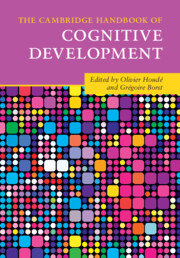Book contents
- The Cambridge Handbook of Cognitive Development
- The Cambridge Handbook of Cognitive Development
- Copyright page
- Contents
- Figures
- Tables
- Contributors
- Introduction
- Part I Neurobiological Constraints and Laws of Cognitive Development
- 1 How Life Regulation and Feelings Motivate the Cultural Mind
- 2 Epigenesis, Synapse Selection, Cultural Imprints, and Human Brain Development
- 3 Mapping the Human Brain from the Prenatal Period to Infancy Using 3D Magnetic Resonance Imaging
- 4 Development and Maturation of the Human Brain, from Infancy to Adolescence
- 5 Genetic and Experiential Factors in Brain Development
- 6 The Brain Basis Underlying the Transition from Adolescence to Adulthood
- Part II Fundamentals of Cognitive Development from Infancy to Adolescence and Young Adulthood
- Part III Education and School-Learning Domains
- Index
- Plate Section (PDF Only)
- References
4 - Development and Maturation of the Human Brain, from Infancy to Adolescence
from Part I - Neurobiological Constraints and Laws of Cognitive Development
Published online by Cambridge University Press: 24 February 2022
- The Cambridge Handbook of Cognitive Development
- The Cambridge Handbook of Cognitive Development
- Copyright page
- Contents
- Figures
- Tables
- Contributors
- Introduction
- Part I Neurobiological Constraints and Laws of Cognitive Development
- 1 How Life Regulation and Feelings Motivate the Cultural Mind
- 2 Epigenesis, Synapse Selection, Cultural Imprints, and Human Brain Development
- 3 Mapping the Human Brain from the Prenatal Period to Infancy Using 3D Magnetic Resonance Imaging
- 4 Development and Maturation of the Human Brain, from Infancy to Adolescence
- 5 Genetic and Experiential Factors in Brain Development
- 6 The Brain Basis Underlying the Transition from Adolescence to Adulthood
- Part II Fundamentals of Cognitive Development from Infancy to Adolescence and Young Adulthood
- Part III Education and School-Learning Domains
- Index
- Plate Section (PDF Only)
- References
Summary
This chapter describes basic principles and key findings regarding the development and maturation of the human brain, the former referring to the pre-natal and early post-natal periods, and the latter concerning childhood and adolescence. In both cases, we focus on brain structure as revealed in vivo with multi-modal magnetic resonance imaging (MRI). We begin with a few numbers about the human brain and its cellular composition, and a brief overview of a number of MRI-based metrics used to characterize age-related variations in grey and white matter. We then proceed with synthesizing current knowledge about developmental and maturational changes in the cerebral cortex (its thickness, surface area and intra-cortical myelination), and the underlying white matter (volume and structural properties). To facilitate biological interpretations of MRI-derived metrics, we introduce the concept of virtual histology. We conclude the chapter with a few notes about future directions in the study of factors shaping the human brain from conception onwards.
- Type
- Chapter
- Information
- The Cambridge Handbook of Cognitive Development , pp. 85 - 104Publisher: Cambridge University PressPrint publication year: 2022



